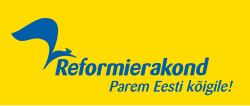Estonian Reform Party
| Eesti Reformierakond Estonian Reform Party |
|
|---|---|

|
|

|
|
| Party leader | Kaja Kallas |
| Honorary Chairman | Siim Kallas |
| founding | November 18, 1994 |
| Headquarters |
Tõnismägi 9 10119 Tallinn |
| Alignment |
Liberalism Classical Liberalism Conservatism |
| Colours) | Yellow blue |
| Parliament seats |
34/101 |
| Number of members | 12,172 (2018) |
| International connections | Liberal International |
| MEPs |
2/7 |
| European party | Alliance of Liberals and Democrats for Europe (ALDE) |
| EP Group | Renew Europe (RE) |
| Website | www.reform.ee |
The Estonian Reform Party (Estonian Eesti Reformierakond , RE) is a classically liberal party . Its chairman has been Kaja Kallas since April 2018 .
Positions and Profile
The Reform Party advocates classically liberal politics, which means that it advocates a high degree of individual freedom in all areas of life. She not only called for a lowering of the flat tax to 18% by 2011 or an abolition of corporation tax for reinvested income, but also takes a stand against compulsory military service and advocates the legalization of soft drugs.
The Reform Party is a member of the Liberal International and the Alliance of Liberals and Democrats for Europe . Their colors are blue and yellow.
History and Development
On November 13, 1994 RE was founded by the then central bank president and "father of the Estonian kroon ", Siim Kallas . In the parliamentary elections the following year, the newly founded party immediately became the second-strongest force behind the social-liberal Estonian coalition party with 16.2% and 19 of the 101 seats . After a cabinet reshuffle in November 1995, she entered into a coalition government under Tiit Vähi , and Kallas became Foreign Minister. A year later the coalition broke up, the RE went into opposition. In 1999, after being confirmed in the elections (15.9%; 18 seats), it again formed a coalition with the Fatherland Union and the People's Party - The Moderates (now the Estonian Social Democratic Party ) under Mart Laar . After their breakup, Kallas was elected prime minister himself, and the Estonian Center Party belonged to his government . Its pro-European policy led to a slight gain in the 2003 parliamentary elections. 17.7% voted for the party, so that it was again able to send 19 MPs to the Riigikogu . The Reform Party continued to be involved in the government, but Juhan Parts from the Res Publica took over the government, and the People's Union , a left-wing conservative farmers' party , was also involved in the government . In 2004 Siim Kallas went to Brussels as EU Commissioner. Andrus Ansip , the popular mayor of Tartu, succeeded him as party chairman . After Parts' resignation, Res Publica also left the government. Ansip, who took the Center Party back into government, became the new Prime Minister.
In the parliamentary elections in March 2007, RE was able to grow strongly. It now got 27.8% of the vote and 31 seats. After the election, the reform party formed a coalition government with the conservative Isamaa ja Res Publica Liit (IRL) and the Social Democrats , from which the Social Democrats left in May 2009. In the election on March 6, 2011 , the reform party was able to increase its result again and achieve its best result to date with 28.6% of the vote and 33 MPs in the Riigikogu . Andrus Ansip continued the reform party's coalition with the IRL, but it broke up during the electoral term. A coalition government made up of reforms and social democrats under Prime Minister Taavi Rõivas followed in 2014 . In the 2015 parliamentary election , the reform party suffered small losses, but formed a coalition with the IRL and the Social Democrats again. Taavi Rõivas was confirmed as prime minister. However, this coalition also broke up prematurely at the end of 2016 and the two smaller parties now formed a coalition with the Center Party. Hanno Pevkur then became party chairman, shortly followed by the party's daughter, Kaja Kallas .
Election results
| year | be right | proportion of | Mandates | space |
|---|---|---|---|---|
| 1995 | 87,531 | 16.2% |
19/101 |
2. |
| 1999 | 77,088 | 14.9% |
18/101 |
3. |
| 2003 | 87,551 | 17.7% |
19/101 |
3. |
| 2007 | 153.044 | 27.8% |
31/101 |
1. |
| 2011 | 164.255 | 28.6% |
33/101 |
1. |
| 2015 | 158,885 | 27.7% |
30/101 |
1. |
| 2019 | 162,332 | 28.8% |
34/101 |
1. |
| year | be right | proportion of | Mandates | space |
|---|---|---|---|---|
| 2004 | 28,377 | 12.2% |
1/6 |
3. |
| 2009 | 60,877 | 15.3% |
1/6 |
3. |
| 2014 | 79,849 | 24.3% |
2/6 |
1. |
| 2019 | 87,160 | 26.2% |
2/7 |
1. |
Party leader
- Siim Kallas (1994-2004)
- Andrus Ansip (2004-2014)
- Taavi Rõivas (2014-2017)
- Hanno Pevkur (2017-2018)
- Kaja Kallas (since 2018)

